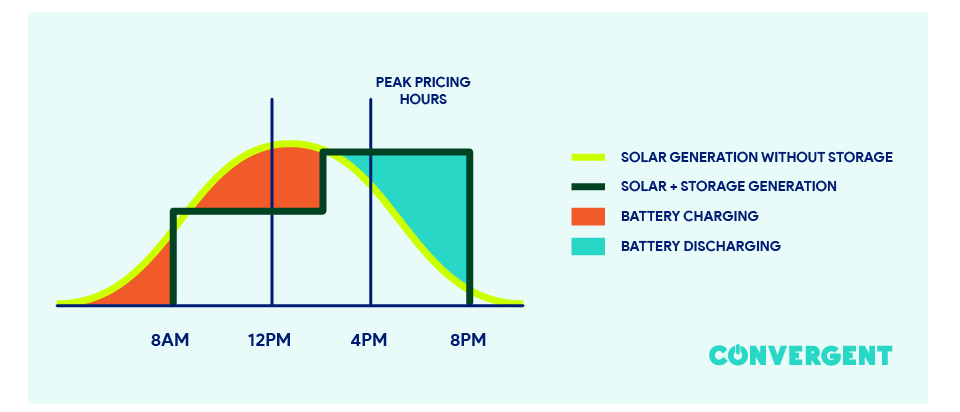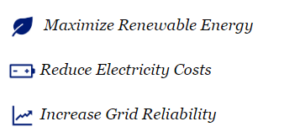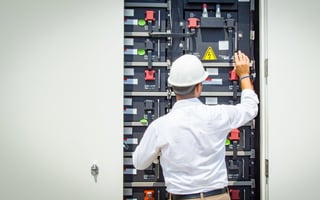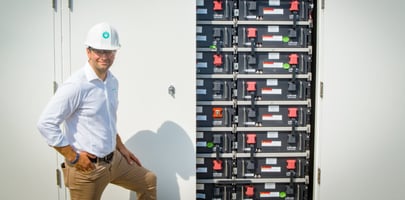Energy Storage 101: How Energy Storage Works

Why Energy Storage
Energy storage is the linchpin of the clean energy transition. The more renewable energy on the grid, the better—but these resources only produce power when the sun is shining, or the wind is blowing. Energy storage can “firm up” renewable resources, maximizing their value to the grid. In addition, energy storage can reduce the cost of electricity (storing energy when it is cheapest, dispatching it when it is most expensive), and increase the reliability of our aging electric grid increasingly strained by climate change.
Why Energy Storage NOW
Historically, power on the grid has flowed in one direction (from generation to transmission to distribution to customers) but with more and more customers producing their own power, i.e., solar panels at businesses or residences, power is now flowing in multiple directions. The grid was not built for this. Nor was it built for the proliferation of extreme weather events produced by climate change.
The future of energy depends on our ability to store it. We need energy storage to accelerate the clean energy transition, reduce costs, and increase reliability for businesses, utilities, and communities.
I’m Ready to Lower my Costs and Carbon Emissions with Energy Storage
The Key Benefits of Energy Storage
How Energy Storage Works
Without energy storage (i.e., how the electric grid has been for the past century), electricity must be produced and consumed exactly at the same time. When you turn on a hairdryer in your home, somewhere, an electricity generation plant is turning up just a tiny bit to keep the grid in balance. Energy storage systems allow electricity to be stored—and then discharged—at the most strategic times. Today, Lithium-ion batteries, the same batteries that are used in cell phones and electric vehicles, are the most commonly used type of energy storage. Like the batteries in your cell phone, commercial-, industrial-, and utility-scale battery energy storage systems can be charged with electricity from the grid, stored, and discharged when there is a deficit in supply or when energy is most expensive. Increasingly, battery energy storage is being paired with solar PV, which maximizes the value of solar energy to the grid (i.e., storing solar-generated electricity for when it is cloudy or after the sun sets).
Convergent’s AI-powered energy storage intelligence, PEAK IQ®, makes data-driven decisions about when and how to charge and discharge energy storage systems for optimal value creation and value stacking.
Primary Energy Storage Technologies
- Battery Storage
- Battery energy storage systems (BESS) are charged and discharged with electricity from the grid. Lithium-ion batteries are the dominant form of energy storage today because they hold a charge longer than other types of batteries, are less expensive, and have a smaller footprint. Batteries do not generate power; batteries store power. As a result, knowing when to charge and discharge a battery storage system is critical. In most cases, this means charging when energy is least expensive and discharging when energy is most expensive. Battery storage is an increasingly popular solution for businesses and utilities looking to reduce their energy costs and carbon footprint at the same time.
See it in action:
- Solar-Plus-Storage
- Solar panels only generate electricity when the sun is shining. Humans, of course, do not only use electricity when the sun is out. This is why finding a way to reliably store and access those electrons (i.e. energy storage) is key to the clean energy transition. A solar-plus-storage system is a battery system that is charged by a connected solar system, such as a photovoltaic (PV) one. In other words, solar-plus-storage combines a battery energy storage system with solar PV to reduce a customer’s energy costs and carbon footprint at the same time.
See it in action:
- Flywheels
- Flywheels store energy as kinetic energy by accelerating a rotor (also known as a flywheel) to very high speeds and maintaining that energy in the form of rotational energy. Flywheels have storage capacities comparable to batteries and faster discharge rates. They are mainly used to provide load leveling or grid frequency regulation services by balancing changes between supply and demand.
See it in action:
- Pumped Hydropower
- Hydropower, or hydroelectric power, is one of the original and most prevalent forms of renewable energy, using the natural flow of moving water to generate electricity. Pumped storage hydropower (PSH) is a form of hydroelectric energy storage that uses water reservoirs at two different elevations that can behave similarly to a giant battery. In PSH, water is pumped from the lower reservoir to the higher reservoir and generates energy when released. While a highly sustainable form of energy storage, PHS requires access to a very specific landscape, limiting its use.
The Key Applications for Energy Storage
- Coincident Peak Demand Charge Avoidance
- PEAK IQ, Convergent’s energy storage intelligence software, can forecast electric system peaks and discharge the system at those times, reducing electricity costs and the need for additional generation. This is also known as “peak hitting” or “peak shaving.”
- Non-Coincident Peak Demand Charge Avoidance:
- PEAK IQ can forecast a facility’s peak usage times and dispatch an energy storage system during those hours, reducing electricity costs.
- Energy Arbitrage
- Because electricity historically could not be stored, electricity prices are usually time-dependent – i.e., they are more expensive during times when people need it most (e.g., a hot summer afternoon) and cheapest when it’s needed least. Energy arbitrage takes advantage of “time of use” electricity pricing by charging an energy storage system when electricity is cheapest and discharging when it is most expensive.
- Solar Firming
- Solar firming with energy storage uses the asset to “firm” or smooth any gaps that may arise between the solar energy supply and the demand due to clouds or time of day.
- Non-Wires-Alternative (NWA)
- The power lines on which electricity is transported (“transmission” and “distribution” lines) are expensive to build and maintain, and incredibly difficult to site, as most people do not want new power lines near them. By increasing capacity and resiliency on the grid at the most strategic times, intelligently deployed energy storage avoids or defers the need to build out new infrastructure (wires), which is called a Non-Wires Alternative.
- Capacity
- Energy storage provides additional local and system capacity at the most critical times.
- Ancillary Services
- Energy storage intelligence like PEAK IQ enables an asset to provide ancillary services to the electric grid, including Frequency Regulation and Operating Reserves.
How can Energy Storage Benefit my Organization?
Energy Storage Sector Key Takeaways
- Battery storage creates a smarter, more flexible, and more reliable grid.
- Energy storage is the linchpin of our clean energy future.
- There are multiple applications for energy storage to add value to customers and the grid today.
- Ultimately, both short- and long-duration energy storage are essential to transitioning away from fossil fuels.
- Ensuring equal treatment of battery storage from both policy and market perspectives will further accelerate the clean energy transition.
I’m Ready to Talk Energy Storage
Further Reading About Energy Storage





